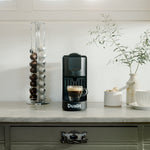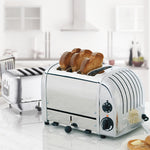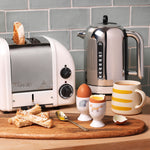The Cake
You can choose to ice a sponge cake or a fruit cake depending on the occasion and your own preference. Very rich cakes such as traditional wedding or Christmas cakes improve by being stored for some weeks or even months. They should be well wrapped in greaseproof paper and stored in a cold, dry place.
Your cake should be well proportioned and have a level top. If the cake is slightly domed you can use the bottom of the cake for the top or level it with marzipan before applying a layer of marzipan icing.
Equipment
You will need a Tala Icing Syringe Set or an icing bag set with a selection of nozzles to create different designs. You will find that a turntable, whilst not essential, will make decorating your cake much easier.
In addition you will need a sieve, a palette knife (or steel rule), mixing bowls and a wooden spoon or spatula.
The First Step:
Iced cakes usually have a layer of marzipan under the icing. Marzipan can be shop bought or you can follow our easy recipe here.
To apply the marzipan:
- Brush the surface of your cake with warmed, sieved apricot jam to help the marzipan stick.
- Halve the marzipan. Sprinkle icing sugar on a board to prevent sticking. Roll out one half to a strip as wide as the cake and long enough to go round it (measure the circumference with a piece of string). Fit around the edge of the cake using a rolling pin to help it adhere. Make sure it is just above the edge on top, trim the bottom.
- Roll out the other half into a round to fit the top of the cake. Turn the cake upside down onto the marzipan and trim round the cake. Turn back over and roll the top with the rolling pin to adhere.
Icing the top and sides
Now the cake is ready to be iced. Royal Icing has a hard, glossy surface perfect for cake decoration. Click here for Tala's royal icing recipe.
You will need a palette knife and a turntable or, failing this, an upturned cake tin on which to stand the cake. Every time, before using it, the palette knife should be dipped into hot water and shaken afterwards.
Top: Put some icing on the cake and spread it with the palette knife all over the top, right to the edge. To level and smooth the surface take the knife with both hands and holding it quite straight, draw the edge of the blade right across the top. Put surplus icing back into the bowl.
Sides: Spread icing roughly over the sides of the cake. To smooth the sides of a round cake stand the damp palette knife with its edge against the cake and revolve the turntable. When finished lift the knife off gently. Without a turntable or with a square cake you have to rely on the steadiness of your hand and the accuracy of your eye. Take special care of the edge and make it as neat as possible. Remove any excess from the bottom edge of the cake.
Allow to dry in a dust-free, airy and not too warm place for 24 hours. After this you can apply a second coat or place the cake on a cake board ready for decorating.
First efforts in decoration
Perfect piping is a question of practice so don't despair if you find it difficult at first. Before starting on your cake practice your piping on a plate or piece of paper until you get used to the process. For decorative piping the icing should stand up in peaks.
Using a syringe
Using a teaspoon or palette knife fill the syringe, about half way, replace the plunger and secure it with a sharp turn to the right. Press down with the plunger and, as soon as the icing appears at the opening, screw on the nozzle.
Insert your thumb into the ring at the end of the plunger and your index and third fingers will slip quite naturally into the other rings. A slight pressure with the thumb will now be sufficient to eject icing. Support the syringe body with your other hand.
Using an icing bag
First fit the nozzle. Scoop up some icing on a palette knife and place it deep into the bag; it may help to fold the bag to do this. Hold the bag together as you carefully withdraw the knife. When the bag is one quarter full twist it together behind the icing. Hold the bag with your leading hand and gently squeeze down towards the nozzle to release the icing. Support the bag with your other hand.
*TIP* The heat from your hands may affect the consistency of the icing as you pipe, causing it to dry and crack. To avoid this use small amounts and refill often.
Piping Techniques
Here are a few tips to get you started….
To pipe a straight line:
- Place the tip of the nozzle at the place where you want to begin. As you squeeze out the icing lift the nozzle slightly away from the surface and, still squeezing, move the nozzle steadily in the direction of the line to be piped, keeping the icing flowing evenly
- Lower the tip of the nozzle gently onto the surface where you want the line to end and release the pressure. Never attempt to pipe a line with the nozzle touching the surface as this will result in an uneven finish.
Stars and shells
- Attach a star nozzle. Hold the syringe in an upright position with the nozzle about 3mm away from the surface. Press out a little icing, release the pressure and quickly lift off the syringe. The result will be a little star.
- Shell patterns can be formed using the same nozzle but holding the syringe at 45 degrees. Squeeze the icing onto the surface, lift the tube slightly, guide it away from you then back towards you and finish down on the surface.
Borders
- Borders can be created by piping rows of dots, shells and stars.
- Continuous borders and ribbons are more difficult but a turntable can make this task easier. Garlands and looped ribbons allow you to make breaks in the border and this gives you more control.
Writing
- You can use a nozzle or icing pen. The icing should be softer for writing - but stiff enough to hold a round shape when piped. First write your message on paper and practice piping over it. You will need to keep the icing flowing for each stroke or letter to achieve a smooth line. Once you are satisfied with the result write the message again on paper and place it on position on the cake. Use a pin to prick through the key points of the letters on to the surface of the cake and then ice over your template.
The Art of Icing is simple with Tala sets. Visit the website to view the range of quality icing equipment and complete range of kitchenware www.talacooking.com











